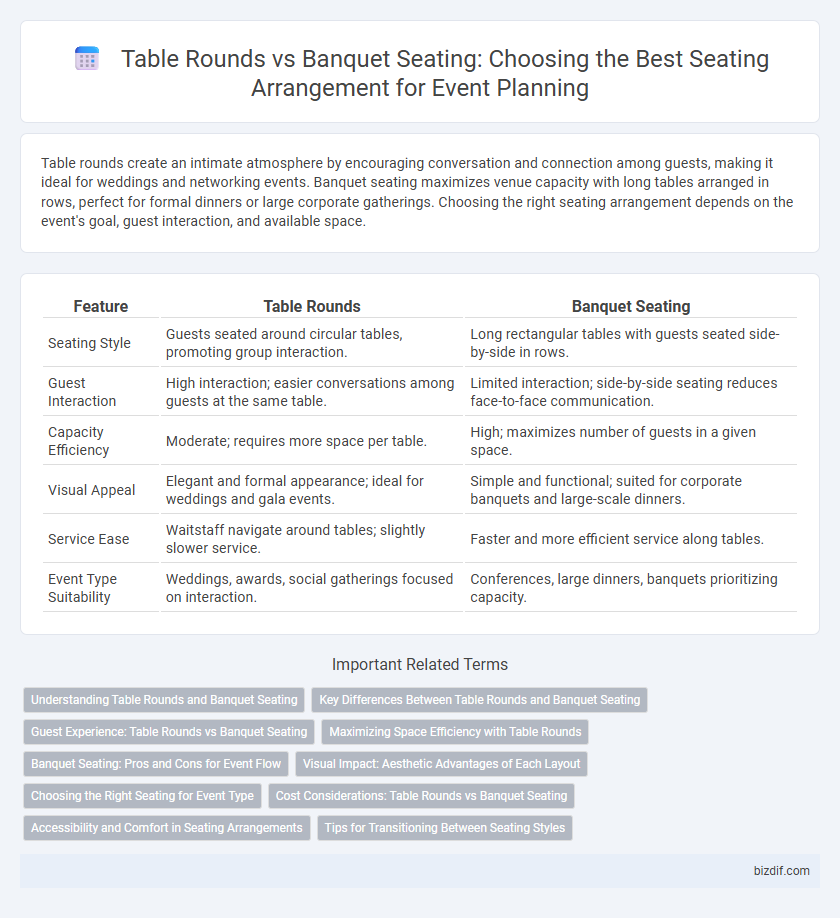Table rounds create an intimate atmosphere by encouraging conversation and connection among guests, making it ideal for weddings and networking events. Banquet seating maximizes venue capacity with long tables arranged in rows, perfect for formal dinners or large corporate gatherings. Choosing the right seating arrangement depends on the event's goal, guest interaction, and available space.
Table of Comparison
| Feature | Table Rounds | Banquet Seating |
|---|---|---|
| Seating Style | Guests seated around circular tables, promoting group interaction. | Long rectangular tables with guests seated side-by-side in rows. |
| Guest Interaction | High interaction; easier conversations among guests at the same table. | Limited interaction; side-by-side seating reduces face-to-face communication. |
| Capacity Efficiency | Moderate; requires more space per table. | High; maximizes number of guests in a given space. |
| Visual Appeal | Elegant and formal appearance; ideal for weddings and gala events. | Simple and functional; suited for corporate banquets and large-scale dinners. |
| Service Ease | Waitstaff navigate around tables; slightly slower service. | Faster and more efficient service along tables. |
| Event Type Suitability | Weddings, awards, social gatherings focused on interaction. | Conferences, large dinners, banquets prioritizing capacity. |
Understanding Table Rounds and Banquet Seating
Table rounds create an intimate and interactive environment by arranging guests in circular tables, typically seating 8 to 10 people, which facilitates conversation and engagement. Banquet seating involves long rectangular tables positioned in rows or blocks, maximizing space and accommodating larger groups efficiently. Understanding the differences in layout, guest interaction, and space utilization is essential for selecting the optimal seating arrangement for events such as weddings, corporate dinners, or conferences.
Key Differences Between Table Rounds and Banquet Seating
Table rounds typically accommodate 8 to 12 guests, promoting intimate conversation and easy interaction, making them ideal for weddings and gala dinners. Banquet seating arranges guests in long rows or rectangular tables, maximizing space efficiency and allowing more attendees in a given area, often used for corporate events or large banquets. The key difference lies in their spatial design and social dynamics: round tables encourage engagement, while banquet seating prioritizes capacity and streamlined service.
Guest Experience: Table Rounds vs Banquet Seating
Table rounds promote interactive guest experiences by facilitating easy conversation and eye contact among attendees, enhancing social engagement during events. Banquet seating maximizes space efficiency, allowing for larger guest capacities but may limit interpersonal interactions due to linear arrangement. Choosing between table rounds and banquet seating should align with event goals, prioritizing either guest interaction or capacity optimization.
Maximizing Space Efficiency with Table Rounds
Maximizing space efficiency with table rounds involves strategically arranging circular tables to optimize guest capacity without compromising comfort. Round tables promote social interaction and facilitate easy movement for servers, enhancing the overall event experience. Proper spacing calculations allow planners to maximize venue capacity while maintaining clear pathways and fire safety compliance.
Banquet Seating: Pros and Cons for Event Flow
Banquet seating enhances event flow by facilitating efficient service and creating a formal atmosphere ideal for large gatherings. This seating arrangement maximizes space usage, allowing for more guests in a given area, but it can limit guest interaction compared to round tables. However, banquet seating may restrict movement, which could affect networking opportunities and the overall social dynamics of the event.
Visual Impact: Aesthetic Advantages of Each Layout
Round tables create an inviting and elegant atmosphere by promoting intimacy and balanced visual flow, ideal for gala dinners or weddings that emphasize guest interaction. Banquet seating offers a streamlined, symmetrical aesthetic that maximizes space efficiency and creates a formal, organized look suitable for corporate events or large conferences. The choice between round and banquet seating depends on the desired ambiance, visual coherence, and event type, balancing aesthetic appeal with practicality.
Choosing the Right Seating for Event Type
Round tables offer a more intimate and interactive setting, ideal for social events, weddings, and networking gatherings where guest interaction is prioritized. Banquet seating maximizes space efficiency, making it suitable for conferences, formal dinners, and events requiring clear sightlines to a stage or speaker. Choosing the right seating depends on event objectives, guest dynamics, and the desired atmosphere to enhance attendee experience and engagement.
Cost Considerations: Table Rounds vs Banquet Seating
Table rounds often require more space and linens, leading to higher rental and venue costs compared to banquet seating, which maximizes room capacity with long tables. The additional chairs and centerpieces for round tables increase overall expenses, making banquet seating a more budget-friendly option for large events. Event planners must balance aesthetic preferences with cost efficiency when choosing between table rounds and banquet seating.
Accessibility and Comfort in Seating Arrangements
Round tables promote accessibility by allowing guests to easily engage in conversation and access shared dishes, enhancing overall comfort. Banquet seating optimizes space but can limit individual movement and interaction due to linear seating formats. Prioritizing ergonomic chair options and clear aisle pathways in both arrangements ensures a comfortable and accessible environment for all attendees.
Tips for Transitioning Between Seating Styles
When transitioning between table rounds and banquet seating, prioritize efficient space allocation to maximize guest comfort and flow. Ensure clear communication with vendors and staff to facilitate quick furniture rearrangement and maintain event timing. Use modular furniture and pre-marked floor plans to streamline setup and minimize disruption during the transition.
Table rounds vs banquet seating Infographic

 bizdif.com
bizdif.com